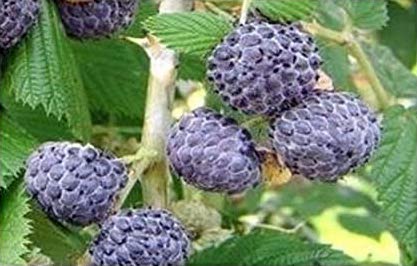Rubus leucodermis
Rubus leucodermis, commonly known as the black raspberry, whitebark raspberry, or blue raspberry, is a species of Rubus in the Rosaceae family, native to western North America. This plant is known for its distinctive white to very light blue stem and delicious fruits, which are consumed fresh and used in various culinary applications. The species plays a significant role in wildlife habitat, serving as a food source for various animals and insects.
Description[edit | edit source]
Rubus leucodermis is a perennial plant with biennial stems (canes) from a perennial root system. In its first year, a new stem grows vigorously to its full height of 1-3 meters, bearing large pinnate leaves with 3 or 5 leaflets; these stems are known as primocanes. In the second year, the stem does not grow taller but produces several side shoots, which bear smaller leaves with 3 leaflets; these are called floricanes. The stems are covered in a white to light blue waxy coating, giving rise to the common name "whitebark raspberry". The flowers are 2-3 cm in diameter, with five white petals, and mature into a composite fruit in the late summer or early fall.
Habitat and Distribution[edit | edit source]
Native to western North America, the range of Rubus leucodermis extends from British Columbia in Canada through the western United States to California, and east to Montana and Idaho. It typically grows in open forests, forest edges, and clearings, thriving in well-drained, loamy soils. It is also found in disturbed areas, indicating its adaptability to various environments.
Cultivation and Uses[edit | edit source]
While not as commonly cultivated as its relative, the red raspberry (Rubus idaeus), Rubus leucodermis is valued for its fruits, which are used in making jams, jellies, and pies, as well as being eaten fresh. The berries are known for their rich color and flavor, which is often described as more intense than that of the red raspberry. In addition to its culinary uses, the plant is also grown as an ornamental in gardens and landscapes for its attractive foliage and stems.
Conservation[edit | edit source]
As a native species, Rubus leucodermis does not face significant threats at a global level. However, habitat destruction and the use of herbicides can locally impact its populations. Conservation efforts focus on preserving its natural habitats and promoting its cultivation in home gardens and agricultural settings.
Gallery[edit | edit source]
Note: As per the instructions, no placeholder images are included.
See Also[edit | edit source]
Navigation: Wellness - Encyclopedia - Health topics - Disease Index - Drugs - World Directory - Gray's Anatomy - Keto diet - Recipes
Search WikiMD
Ad.Tired of being Overweight? Try W8MD's physician weight loss program.
Semaglutide (Ozempic / Wegovy and Tirzepatide (Mounjaro) available.
Advertise on WikiMD
WikiMD is not a substitute for professional medical advice. See full disclaimer.
Credits:Most images are courtesy of Wikimedia commons, and templates Wikipedia, licensed under CC BY SA or similar.
Contributors: Prab R. Tumpati, MD

